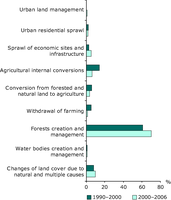
Proportion of each land cover flows in the total amount of land cover changes observed in mountainous regions.

The graph describes the % of each CLC Class by each country withing mountain areas of non EU-27 using as reference the proportion of the area of each class

Comparison of the distribution of land cover changes according to the LEAC land cover flow classification in mountain massifs, between EU-15 members (excluding Denmark, Finland, The Netherlands, Sweden) and new EU-27 members (excluding Cyprus, Estonia, Latvia, Lithuania.)

The map shows the annual diffuse agricultural emissions of nitrogen to freshwater

This bar graphic shows the number of NGOs enjoying advisory status with the UN Economic and Social Council (ECOSOC) from 40 countries in 1948 to 3187 countries in 2008.

The figure compares the proliferation of twenty-three environmental policy innovations between 1945 and 2005 across 43 OECD and Central Eastern European Countries. The colours represent adoption levels from dark blue (less than 4 countries adopting the policy) to brown (more than 40 countries adopting it). The policies are ranked by adoption rate between start year and 2005 (fastest spreading policies first).

This horizontal bar graphic shows the numbers of bilateral (left-hand axis) and multilateral (right-hand axis) environmental agreements started each year since 1900. It distinguishes original agreements and protocols (darker orange).

The bar graphic compares current (2005) and projected (2015 and 2030) chemicals production for 3 world regions in USD. The map precise the regions considered: OECD countries (darker blue), BRIICS countries (red), and rest of the world (pale blue).

The 2 line graphics show SO2 and NOx emission trends from 1970 to 2050 according to 4 scenarios: the baseline, Global PP, OECD+BRIC PP, Global PP

The maps show projected impacts of climate change on terrestrial ecosystems: forest cover gain, shrub/woodland cover gain, herbaceous cover gain, desert amelioration, grass/tree cover loss, forest/woodland decline, forest type change, according to 2 climate scenarios (SRES B1 and SRES A2).

2 comparable maps showing current (2000) and projected (2030) PM10 regional concentrations (population weighted).

Global scheme of nitrogen cycle, showing major nitrogen reservoirs (atmosphere, soil and living organisms), major processes (nitrification, denitrification, nitrogen fixation, assimilation etc.) and actors (plants, animals, bacteria, human beings).

The maps show projected ocean acidification and related impacts on corals by 2020, 2060 and 2100: from better (blue) to worse (orange) conditions for coral skeletal growth.

For the graph: 2006 and projected 2030 world use of neodymium, germanium and tantalum. The technologies responsible for the growth in use of these materials by 2030 are indicated in red. For the map: The bars show estimated reserves of rare earth elements, germanium and tantalum.

Top graph: From traditional to modern health risks, this “health transition” scheme describes the relation between development and health, distinguishing behavioural risks and the correlated diseases and death causes. Some risks are specifically related to developing countries (blue part of the scheme), others are typically worrying in developed countries (brown part) and some occur everywhere (blue and brown intersection).
Bottom graph: Comparison between 2008 and 2030 projected causes of death for 2 income groups.showing the growing projected imoortance of cardiovascular diseases and cancers.

Eastern: Bulgaria (1990;2007), Czech Republic (1990;2007), Hungary (1992;2006), Latvia (1991;2007), Poland (1990;2007), Romania (1990;2006), Slovakia (1990;2007), Slovenia (1990;2007), Western: Austria (1990;2002), Belgium (1994;2007), Denmark (1990;2004), England & Wales (1990;2006), Finland (1994;2005), Germany (1995;2002), Netherlands (1995;2006), Norway (1995;2006), Sweden (1990;2007), Southern: France (1991;2006), Greece (1990;2007), Portugal (1990;1998), Spain (1991;2006), Turkey: (1995; 2007) Turkey is plotted on an individual column in this graph to depict the large increase in agricultural water use, and to avoid the projection of this trend/effect on the Southern countries trend.

Water which the industry abstracts directly from surface or ground water, in addition to or as a replacement for the public water supply. This excludes water abstracted for cooling purposes only, as well as all power stations.
Eastern:
Bulgaria (1990;2007), Czech Republic (1990;2007), Hungary (1992;2006), Latvia (1991;2007), Poland (1990;2007), Romania (1990;2006), Slovakia (1990;2007), Slovenia (1990;2007)
Western:
Austria (1990;2002), Belgium (1994;2005), Denmark (1990;2004), England & Wales (1990;2006), Finland (1990;2005), Germany (1991;2004), Iceland (1992;2005), Netherlands (1990;2006), Sweden (1990;2007)
Southern:
France (1990;2006), Spain (1991;2006), Turkey: (1995;2004)

Eastern : Bulgaria (1990;2007), Czech Republic (1990;2007), Estonia (1990;2002), Hungary (1992;2006), Poland (1990;2007), Romania (1991;2007), Western : Austria (1990;2002), Belgium (1994;2005), England & Wales (1990;2004), Finland (1990;2005), Germany (1991;2004), Netherlands (1990;2006), Sweden (1990;2007), Switzerland (1990;2006), Southern: France (1990;2006), Spain (1991;2006), Greece (1990;2007), Turkey: (1994;2006)

Eastern: Bulgaria (1990;2007), Czech Republic (1990;2007), Hungary (1992;2006), Poland (1990;2007), Romania (1990;2007), Slovakia (1990;2007), Slovenia (1990;2007), Estonia (1998;2004), Latvia ( 1997;2007),
Western: Austria (1990;1999), Belgium (1990;2007), Denmark (1990;2004), Finland (1990;2005), Germany (1991;2004), Iceland (1992;2005), Ireland (1994;2007), Netherlands (1990;2005), Norway(1990;2007), Sweden (1990;2007), Switzerland (1990;2006), United Kingdom (1990;2004),
Southern: France (1990;2006), FYR, of Macedonia (1990;2001), Spain (1991;2006), Greece (1997;2007), Portugal (1990;2007),
Turkey: (1995; 2007)

-
Document Actions
Share with others